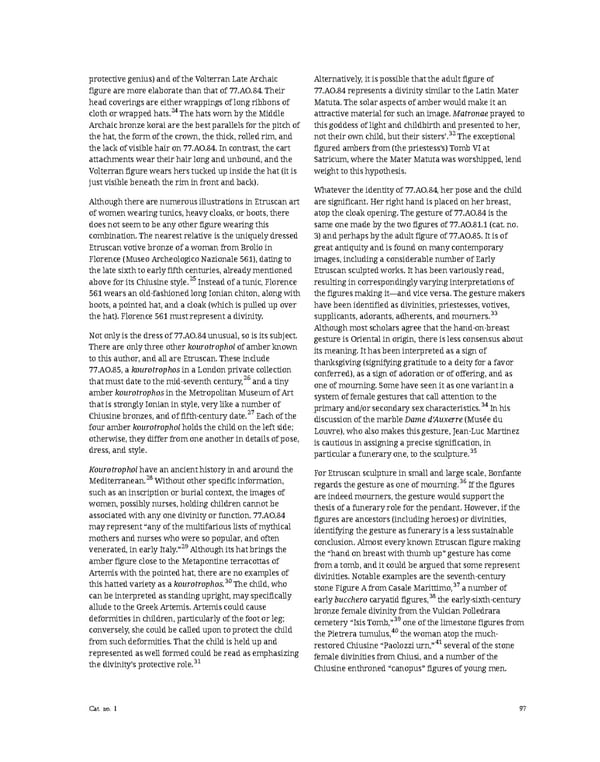protective genius) and of the Volterran Late Archaic Alternatively, it is possible that the adult figure of figure are more elaborate than that of 77.AO.84. Their 77.AO.84 represents a divinity similar to the Latin Mater head coverings are either wrappings of long ribbons of Matuta. The solar aspects of amber would make it an cloth or wrapped hats.24 The hats worn by the Middle attractive material for such an image. Matronae prayed to Archaic bronze korai are the best parallels for the pitch of this goddess of light and childbirth and presented to her, the hat, the form of the crown, the thick, rolled rim, and not their own child, but their sisters’.32 The exceptional the lack of visible hair on 77.AO.84. In contrast, the cart figured ambers from (the priestess’s) Tomb VI at attachments wear their hair long and unbound, and the Satricum, where the Mater Matuta was worshipped, lend Volterran figure wears hers tucked up inside the hat (it is weight to this hypothesis. just visible beneath the rim in front and back). Whatever the identity of 77.AO.84, her pose and the child Although there are numerous illustrations in Etruscan art are significant. Her right hand is placed on her breast, of women wearing tunics, heavy cloaks, or boots, there atop the cloak opening. The gesture of 77.AO.84 is the does not seem to be any other figure wearing this same one made by the two figures of 77.AO.81.1 (cat. no. combination. The nearest relative is the uniquely dressed 3) and perhaps by the adult figure of 77.AO.85. It is of Etruscan votive bronze of a woman from Brolio in great antiquity and is found on many contemporary Florence (Museo Archeologico Nazionale 561), dating to images, including a considerable number of Early the late sixth to early fifth centuries, already mentioned Etruscan sculpted works. It has been variously read, above for its Chiusine style.25 Instead of a tunic, Florence resulting in correspondingly varying interpretations of 561 wears an old-fashioned long Ionian chiton, along with the figures making it—and vice versa. The gesture makers boots, a pointed hat, and a cloak (which is pulled up over have been identified as divinities, priestesses, votives, the hat). Florence 561 must represent a divinity. supplicants, adorants, adherents, and mourners.33 Although most scholars agree that the hand-on-breast Not only is the dress of 77.AO.84 unusual, so is its subject. gesture is Oriental in origin, there is less consensus about There are only three other kourotrophoi of amber known its meaning. It has been interpreted as a sign of to this author, and all are Etruscan. These include thanksgiving (signifying gratitude to a deity for a favor 77.AO.85, a kourotrophos in a London private collection conferred), as a sign of adoration or of offering, and as that must date to the mid-seventh century,26 and a tiny one of mourning. Some have seen it as one variant in a amberkourotrophosin the Metropolitan Museum of Art system of female gestures that call attention to the that is strongly Ionian in style, very like a number of primary and/or secondary sex characteristics.34 In his Chiusine bronzes, and of fifth-century date.27 Each of the discussion of the marble Dame d’Auxerre (Musée du four amberkourotrophoiholds the child on the left side; Louvre), who also makes this gesture, Jean-Luc Martinez otherwise, they differ from one another in details of pose, is cautious in assigning a precise signification, in dress, and style. particular a funerary one, to the sculpture.35 Kourotrophoihave an ancient history in and around the For Etruscan sculpture in small and large scale, Bonfante Mediterranean.28Without other specific information, 36 regards the gesture as one of mourning. If the figures such as an inscription or burial context, the images of are indeed mourners, the gesture would support the women, possibly nurses, holding children cannot be thesis of a funerary role for the pendant. However, if the associated with any one divinity or function. 77.AO.84 figures are ancestors (including heroes) or divinities, may represent “any of the multifarious lists of mythical identifying the gesture as funerary is a less sustainable mothers and nurses who were so popular, and often conclusion. Almost every known Etruscan figure making venerated, in early Italy.”29 Although its hat brings the the “hand on breast with thumb up” gesture has come amber figure close to the Metapontine terracottas of from a tomb, and it could be argued that some represent Artemis with the pointed hat, there are no examples of divinities. Notable examples are the seventh-century this hatted variety as a kourotrophos.30 The child, who 37 stone Figure A from Casale Marittimo, a number of can be interpreted as standing upright, may specifically early bucchero caryatid figures,38 the early-sixth-century allude to the Greek Artemis. Artemis could cause bronze female divinity from the Vulcian Polledrara deformities in children, particularly of the foot or leg; cemetery “Isis Tomb,”39 one of the limestone figures from conversely, she could be called upon to protect the child the Pietrera tumulus,40 the woman atop the much- from such deformities. That the child is held up and restored Chiusine “Paolozzi urn,”41 several of the stone represented as well formed could be read as emphasizing female divinities from Chiusi, and a number of the the divinity’s protective role.31 Chiusine enthroned “canopus” figures of young men. Cat. no. 1 97
 Ancient Carved Ambers in the J. Paul Getty Museum Page 106 Page 108
Ancient Carved Ambers in the J. Paul Getty Museum Page 106 Page 108